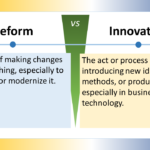The difference between reform and innovation lies in the scope and nature of the changes they entail. Reform is about modifying existing systems or practices to improve them, often without radically altering their fundamental nature.
Innovation involves creating entirely new systems, practices, or technologies that may significantly change or replace the old ones.

Definition
Reform
Reform is the process of making changes to something (such as institutions, laws, or social systems) in order to improve it.
- Characteristics of Reform:
- Incremental Change: Involves gradual adjustments rather than sweeping transformations.
- Systemic Improvement: Aims to enhance existing structures or policies.
- Remedial Action: Seeks to fix specific issues within the current framework.
Innovation
Innovation refers to the implementation of new ideas, products, processes, or services with the objective of improving efficiency, effectiveness, or competitive advantage.
- Characteristics of Innovation:
- Novelty: Introduces new concepts or approaches.
- Disruption: Can alter the way industries or markets function.
- Value Creation: Generates new opportunities and solutions that did not exist before.
More Synonyms on innovation, innovate and innovative
Innovation Terms

Innovation is considered as a driving force in progress.
It includes the introduction of novel ideas, methods, or products that bring positive change and advancement.
For more information about innovations, check our glossary
Relationship and Relevance
Reform and innovation can be complementary. Reforms may be necessary to create an environment conducive to innovation, such as updating intellectual property laws to protect new inventions. Conversely, innovations can drive the need for reform, as new technologies or methods challenge the adequacy of existing regulations or practices.
The key differences between reform and innovation are:
Reform refers to the process of changing or reshaping something to make it better or more effective, while maintaining the core structure or purpose. It involves optimizing and improving existing systems, processes, or policies.
For example, reforming a company's approval process to make it more efficient, or updating government regulations to address issues, would be considered reform.
Innovation, on the other hand, is the introduction of something entirely new - a novel concept, product, service, or way of doing things. It goes beyond just improving the existing and creates something fundamentally different.
Innovations, such as the creation of the smartphone or the ridesharing model pioneered by Uber, disrupt existing industries and change the status quo in a significant way. They are not just incremental improvements, but transformative breakthroughs.
In summary, reform focuses on optimizing the current state, while innovation involves creating something new that changes the game entirely. Reform is about making gradual, iterative changes, while innovation is about radical, structural shifts.
Context for Using Each Term
- Reform is often used in political, legal, and social contexts where changes to established systems are debated or implemented.
- Innovation is more commonly associated with the fields of business, technology, and science, where the development of new ideas and their application are central concerns.
Example of Utilization
A government that adjusts its healthcare policies to provide better coverage for its citizens is undertaking a reform. A healthcare company that develops a groundbreaking new drug or medical device is engaging in innovation.
In conclusion, while reform is about making improvements within existing frameworks, often through policy changes or adjustments, innovation is about creating new frameworks or concepts that can lead to transformative changes in how things are done.
FAQ
Q1: Can reform lead to innovation?
A1: Yes, reforms can create an environment that fosters innovation by removing barriers and encouraging new approaches.
Q2: Is innovation always better than reform?
A2: Not necessarily. The appropriateness of reform or innovation depends on the specific context and goals of the change process.
Q3: How do organizations balance the need for reform and innovation?
A3: Organizations often pursue both strategies simultaneously, reforming existing systems while also investing in innovative initiatives.
Q4: Can innovation occur within a reform process?
A4: Yes, innovative approaches can be incorporated into reform efforts to achieve more effective or efficient outcomes.
Q5: Are there industries that rely more on reform than innovation, or vice versa?
A5: While both are important across sectors, heavily regulated industries like finance or healthcare may focus more on reform, while tech industries often emphasize innovation.

